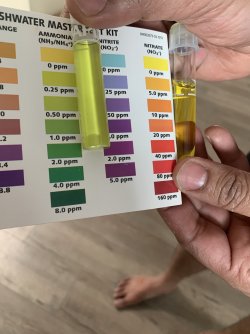The black bit under his chin (bottom of his gill covers) is called a beard. It's a bit of skin male Siamese fighting fish get when they mature. It's normal.
----------
Have you checked the water quality for ammonia, nitrite, nitrate, pH and GH?
If yes, what are the results in numbers?
----------
Fin rot is caused by a dirty environment and or poor water quality that allows harmful bacteria to get into the tissue and eat the fins.
The best way to treat fin rot is by cleaning up the tank conditions.
Do a 75% water change and gravel clean the substrate every day for 2 weeks.
Make sure any new water is free of chlorine/ chloramine before it's added to the tank.
You use bottled water so it should be free of chlorine/ chloramine and doesn't need a water conditioner.
You should aerate the bottled water for at least 5 (preferably 30) minutes before using it in his tank.
Clean the filter if it hasn't been done in the last 2 weeks. Wash the filter media/ materials in a bucket of tank water and re-use the media. Tip the bucket of dirty water on the garden/ lawn.
Keep the fish warm (24-28C).
Increase aeration/ surface turbulence a bit to maximise oxygen levels in the water. Don't have too much movement though otherwise the fish can get knocked around.
----------
You can add salt too. You add 1-2 heaped tablespoons of rock salt, sea salt, or swimming pool salt for every 20 litres (5 gallons) of tank water. Keep the salt in the tank for 2 weeks.
When you do the daily water changes, you add salt to the new water before adding it to the tank so the salinity (salt level) in the tank remains constant.
*NB* Aquarium salt is rock salt.
----------
You can try feeding the fish frozen (but defrosted) and live foods instead of dry foods. Raw or cooked prawn/ shrimp is a good food for them. So are aphids, small ants and ant eggs, small flies caught without chemicals/ sprays. Live brineshrimp is available from most pet shops and can be used to supplement the fish's diet.
The insects can be frozen and fed to him during the day, or you can feed him live insects. I prefer freezing the insects so they don't get out of the tank and buzz around the house.
To use prawn, buy some frozen prawns from a supermarket or fishing store (in the bait freezer) and keep them in your freezer at home. Take one prawn out and defrost it under tap water. Remove the head, shell and gut (thin black tube in the body), and throw these bits away. Use a pair of scissors to cut the remaining prawn tail into small pieces and offer one or two bits at a time. Let the fish eat as much as he can. Remove uneaten food and do a big water change 4-8 hours later.
----------
Post a short video of the fish moving, and check its poop. What colour is its poop?


 Now what ?
Now what ?
